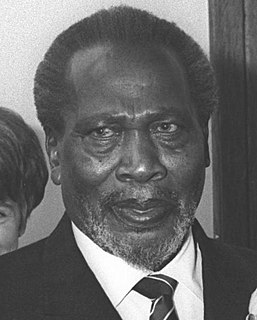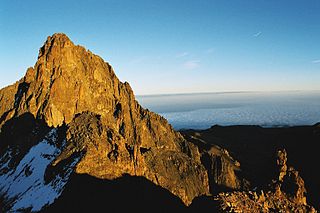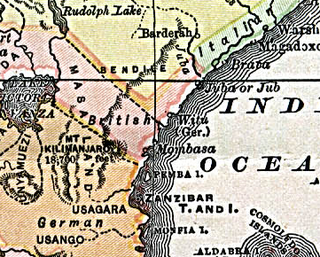 W
WA part of Eastern Africa, the territory of what is now Kenya has seen human habitation since the beginning of the Lower Paleolithic. The Bantu expansion from a West African centre of dispersal reached the area by the 1st millennium AD. With the borders of the modern state at the crossroads of the Bantu, Nilo-Saharan and Afro-Asiatic ethno-linguistic areas of Africa, Kenya is a truly multi-ethnic state.
 W
WThe Carrier Corps was a labour corps created in Kenya during the First World War to provide military labour to support the British campaign against German army forces in East Africa.
 W
WThe Christmas Eve Battle took place during the Mau Mau Uprising on the 24 December 1953 between British Empire and rebel Mau Mau forces and resulted in the death of Earl Wavell, the only son of Archibald Wavell.
 W
WThis page contains a list of chairmen, administrators, commissioners and governors of British Kenya Colony.
 W
WEast Africa Protectorate was an area in the African Great Lakes occupying roughly the same terrain as present-day Kenya—approximately 639,209 km2 (246,800 sq mi)—from the Indian Ocean inland to the border with Uganda in the west. Controlled by Britain in the late 19th century, it grew out of British commercial interests in the area in the 1880s and remained a protectorate until 1920 when it became the Colony of Kenya, save for an independent country 16-kilometre-wide (10 mi) coastal strip that became the Kenya Protectorate.
 W
WEthnic conflicts in Kenya occur frequently, although most are minor skirmishes. A significant increase in the severity of such conflicts between the various ethnic groups inhabiting the country was witnessed after the introduction of multi-party politics in the early 1990s, especially during the 2007–08 Kenyan crisis. Major conflicts have also led to exoduses of ethnic minority communities with roots in other geographical areas.
 W
WThe campaign against female genital mutilation in colonial Kenya (1929–1932), also known as the female circumcision controversy, was a period within Kenyan historiography known for efforts by British missionaries, particularly from the Church of Scotland, to stop the practice of female genital mutilation in colonial Kenya. The campaign was met with resistance by the Kikiyu, the country's largest tribe. According to American historian Lynn M. Thomas, female genital mutilation became a focal point of the movement campaigning for independence from British rule, and a test of loyalty, either to the Christian churches or to the Kikuyu Central Association, the largest association of the Kikuyu people.
 W
WFort Jesus is a fort located on Mombasa Island. Designed by Italian Giovanni Battista Cairati, it was built between 1593 and 1596, by order of King Philip I of Portugal, to guard the Old Port of Mombasa. Fort Jesus was the only fort maintained by the Portuguese on the Swahili coast, and is recognised as a testament to the first successful attempt by a Western power to establish influence over the Indian Ocean trade.
 W
WThe Happy Valley set was a group of hedonistic, largely British and Anglo-Irish aristocrats and adventurers who settled in the "Happy Valley" region of the Wanjohi Valley, near the Aberdare mountain range, in colonial Kenya and Uganda between the 1920s and the 1940s. In the 1930s, the group became infamous for its decadent lifestyles and exploits amid reports of drug use and sexual promiscuity.
 W
WThe Hola massacre was during the Mau Mau Uprising against British colonial rule at a colonial detention camp in Hola, Kenya.
 W
WHyrax Hill is a prehistoric site near Nakuru in the Rift Valley province of Kenya. It is a rocky spur roughly half a kilometer in length, with an elevation of 1,900 meters above sea level at its summit. The site was first discovered in 1926 by Louis Leakey during excavations at the nearby Nakuru Burial Site, and Mary Leakey conducted the first major excavations between 1937 and 1938. There are two distinct areas of occupation at Hyrax Hill: one which was occupied during the Pastoral Neolithic and late Iron Age, and one which was occupied by the Sirikwa earlier in the Iron Age.
 W
WThe Imperial British East Africa Company (IBEACO) was a commercial association founded to develop African trade in the areas controlled by the British Empire. The company was incorporated in London on 18 April 1888, and granted a royal charter by Queen Victoria on 6 September 1888. It was led by William Mackinnon and built upon his company's trading activities in the region, with the encouragement of the British government through the granting of an imperial charter—although it remained unclear what this actually meant.
 W
WJumba la Mtwana is the site of historical structures and archaeological relics on the Indian Ocean coast of Kenya, lying close to the Mtwapa Creek,at Malindi, in Kilifi county, north of Mombasa. It dates back to the fourteenth century. Its features include a mosque by the sea.
 W
WKenya was a sovereign state between 12 December 1963 and 12 December 1964 that shared its head of state with the United Kingdom and other states headed by Queen Elizabeth II. It was a predecessor to the modern-day Republic of Kenya.
 W
WThe Colony and Protectorate of Kenya, commonly known as British Kenya, was part of the British Empire in Africa from 1920 until 1963. It was established when the former East Africa Protectorate was transformed into a British Crown colony in 1920. Technically, the 'Colony of Kenya' referred to the interior lands, while a 16 km (10 mi) coastal strip was the 'Protectorate of Kenya' but the two were controlled as a single administrative unit. The colony came to an end in 1963 when a black majority government was elected for the first time and eventually declared independence as Kenya.
 W
WKenya National Archives and Documentation Services (KNADS) is situated at the edge of the central business district in downtown Nairobi along Moi Avenue next to Ambassadeur Hotel. The archives look out on the landmark Hilton Hotel, while on the rear side is Tom Mboya street. It was established in 1965. It holds 40,000 volumes. It was established by an Act of the Parliament of Kenya in 1965 and was placed under the office of the Vice President and the Minister of Home Affairs. It is currently under the office of the Vice-President and State Department for National Heritage and Culture. The Kenya National Archives building also houses the Murumbi Gallery which contains African artifacts that were collected in the 19th century.
 W
WMount Kenya is the highest mountain in Kenya and the second-highest in Africa, after Kilimanjaro. The highest peaks of the mountain are Batian, Nelion and Point Lenana. Mount Kenya is located in the former Eastern and Central provinces of Kenya, now Meru, Embu, Laikipia, Kirinyaga, Nyeri and Tharaka Nithi counties, about 16.5 kilometres south of the equator, around 150 km (90 mi) north-northeast of the capital Nairobi. Mount Kenya is the source of the name of the Republic of Kenya.
 W
WThe Kikuyu controversy was an Anglican church controversy in 1913-1914.
 W
WIn Kenya under British rule the kipande was an identity document which featured basic personal details, fingerprints, and an employment history. The Native Registration Amendment Ordinance of 1920 made it compulsory for African males above the age of 15. The effect of its adoption was to radically restrict the mobility of Africans. The main intent of the policy, supposedly, was to keep track of the labor pool efficiently. Kipande caused much resentment as all African males were required to wear it at all times around their necks.
 W
WThe Kisumu massacre occurred when the presidential guard and police forces shot and killed several civilians in Kisumu Town, the capital of Nyanza Province in Kenya. This took place on October 25, 1969. The official death toll from government sources stands at 11 fatalities but other sources place this number at closer to 100. Victims included women and children, some of whom were shot 30-50 km away from the epicentre of the riots. According to media reports, the government of the day made attempts to cover up the extent of the massacre.
 W
WThe Mount Elgon insurgency was a conflict that started in 2005 when the Sabaot Land Defence Force militia revolted in the Mount Elgon area, Western Kenya.
 W
WNjoro River Cave is an archaeological site on the Mau Escarpment, Kenya, that was first excavated in 1938 by Mary Leakey and her husband Louis Leakey. Excavations revealed a mass cremation site created by Elmenteitan pastoralists during the Pastoral Neolithic roughly 3350-3050 BP. Excavations also uncovered pottery, beads, stone bowls, basket work, pestles and flakes. The Leakeys' excavation was one of the earliest to uncover ancient beads and tools in the area and a later investigation in 1950 was the first to use radiocarbon dating in East Africa.
 W
WSir Ali bin Salim al-Busaidi was a prominent Arab figure in the Kenyan colonial history. He is also a member of the Al Busaid family that ruled East Africa in the 19th century. His father was the governor of Malindi and then transferred to Mombasa in the late 19th century. Sir Ali al-Busaidi defended the rights of the Arabs in the British colony of Kenya. He established the Seif Bin Salem Library in Mombasa. He played a leading role in establishing the first Arab school in 1912. He also founded another school His name was named in (Malindi).
 W
WThe Battle of Tanga, sometimes also known as the Battle of the Bees, was the unsuccessful attack by the British Indian Expeditionary Force "B" under Major General A.E. Aitken to capture German East Africa during the First World War in concert with the invasion Force "C" near Longido on the slopes of Mount Kilimanjaro. It was the first major event of the war in Eastern Africa and saw the British defeated by a significantly smaller force of German Askaris and colonial volunteers under Lieutenant Colonel Paul von Lettow-Vorbeck. It was the beginning of the East African Campaign of World War I, and is considered as one of greatest victories of the Schutztruppe in Africa. The British retreat enabled the Schutztruppe to salvage modern equipment, medical supplies, tents, blankets, food and a number of Maxim Machine Guns which allowed them to successfully resist the allies for the rest of the War.
 W
WThe Tsavo Man-Eaters were a pair of man-eating male lions in the Tsavo region, which were responsible for the deaths of a number of construction workers on the Kenya-Uganda Railway between March and December 1898. The significance of this lion pair was their unusual behavior of killing men and the manner of their attacks.
 W
WThe Uganda Scheme was a proposal presented at the Sixth Zionist Congress in Basel in 1903 by Zionism founder Theodor Herzl to create a Jewish homeland in a portion of British-controlled East Africa. He presented it as a temporary refuge for Jews to escape rising antisemitism in Europe. At the congress the proposal met stiff resistance.
 W
WThe United Kenya Club is a social and residential club in central Nairobi, Kenya. Founded in 1946, the club was intended as a center for intellectual discussion among Kenyans supporting a nonracial Kenyan society and future. The club provides accommodations, food, and maintains a continued intellectual and political role in Kenya.
 W
WThis is a list of recipients of the Victoria Cross by nationality. It does not include the Victoria Cross awarded to the American Unknown Soldier of World War I Tomb of the Unknowns, buried in Arlington National Cemetery. He was awarded the VC posthumously in 1921. This gesture reciprocated the award of the Medal of Honor to the British Unknown Warrior.
 W
WThe Wanga (AbaWanga) are a tribe of the Luhya people of Kenya. They mainly occupy Butere-Mumias in Kakamega County of Kenya's Western Province.
 W
WWhite people in Kenya or White Kenyans, are those born in or resident in Kenya who descend from Europeans and/or identify themselves as white. Around 0.1% of the population of Kenya is white. There is currently a minor but relatively prominent white community in Kenya, mainly descended from British, but also to a lesser extent Italian and Greek, migrants dating from the colonial period.
 W
WWituland was a territory of approximately 3,000 square kilometres (1,200 sq mi) in East Africa centered on the town of Witu just inland from Indian Ocean port of Lamu north of the mouth of the Tana River in what is now Kenya.
 W
WThe involvement of the British Colony of Kenya in World War II began with the declaration of war on Nazi Germany by the British Empire in September 1939.